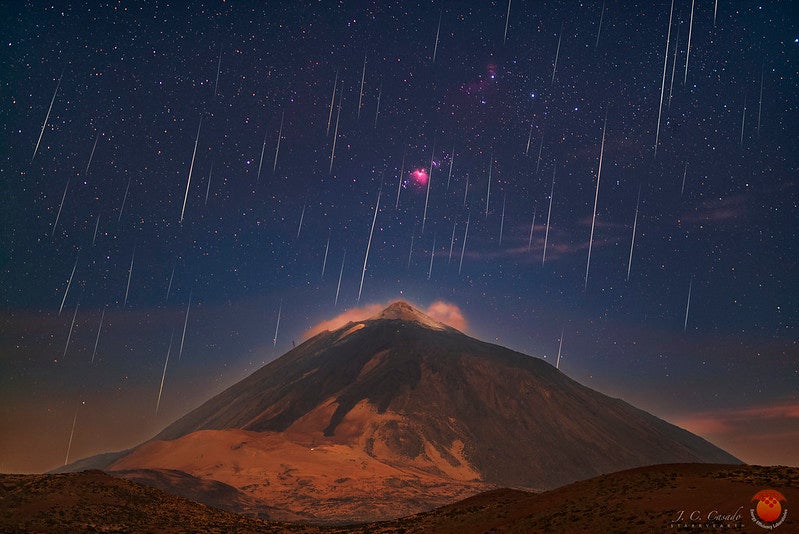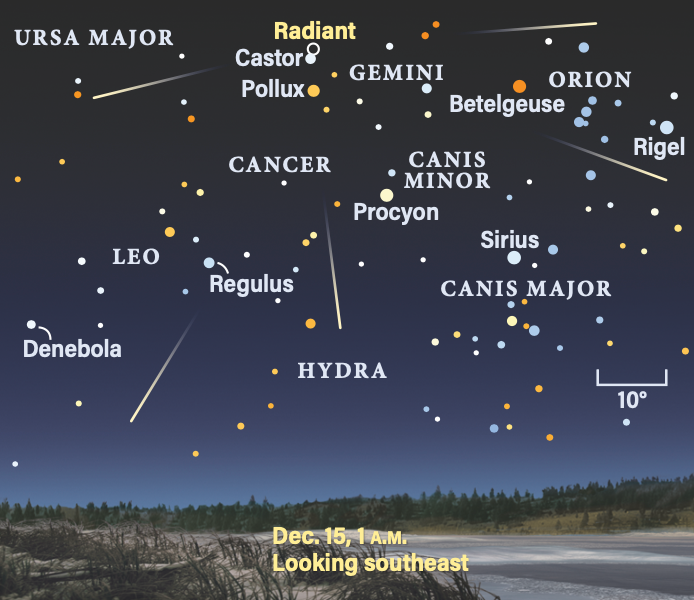
The Geminid meteor shower is one of the most fascinating and thrilling astronomical events it is possible to see, and one of the easiest too. You don’t need a telescope to enjoy it; you don’t even need a pair of binoculars. All you need to do is head to a good observing site under a clear sky, take a seat, and wait. The night sky will do all the work!
The next opportunity to see a good meteor shower is this week, when the annual Geminid shower reaches its peak on Thursday. The Geminids are the favorite shower of many meteor watchers because it can be seen all through the night — you don’t have to set your phone alarm for “You can’t be serious o’clock” — and because its meteors are many and tend to be very bright. And observers are really rubbing their hands with glee this year because the Moon will be well out of the way at the peak of activity. So, weather permitting, we should see quite a show.
It’s important to not get too carried away, though. While social media is useful for spreading information about astronomical events, it is also used to spread a ridiculous amount of misinformation and hype about them too. These days every meteor shower, even the most minor ones, is breathlessly predicted to “light up the sky!”, “dazzle skywatchers!”, and offer a “spectacular display of flaming shooting stars!”
So, what’s actually going to happen this week?
Let’s hit the basics first.
What is a meteor shower?
Contrary to popular belief, shooting stars — officially called meteors — aren’t actually rare enough to warrant making a wish if you see one. (That doesn’t work, by the way — I tried that as a kid and I never married Wonder Woman when I grew up.) On any clear night, if you happen to be looking in the right direction at the right time, you will probably see at least a couple shooting stars skimming across the sky at random. They appear without warning, in any part of the sky.
But around a dozen or so times a year we are guaranteed to see more meteors than usual, all coming from the same direction: a meteor shower. Meteor showers happen when Earth passes through a trail of space dust left behind by a passing comet or asteroid. As these bits of space debris burn up in our atmosphere they create shooting stars, and sometimes lots of them.
Read more: Do meteor showers create meteorites?
What is the Geminids meteor shower?
The Geminids is the name given to a meteor shower that occurs every December. Meteor showers are named after the constellation their shooting stars appear to come from; Geminid meteors shoot out of a point, called the radiant, in the constellation Gemini. Most meteor showers are caused by particles of fluffy comet dust burning up in the atmosphere, but Geminid meteors are different. They are caused by small pieces of rock from the asteroid 3200 Phaeton, so they can appear brighter and more striking than the meteors of other showers.
How many Geminid shooting stars will we see?
That’s the billion-dollar question, isn’t it? Unfortunately, this is where most online coverage of meteor showers makes the biggest mistake and misleads so many people, creating to a lot of disappointment with and also anger at astronomers.
Every shower has a figure called the ZHR, or zenithal hourly rate, which describes how many shooting stars an observer would see each hour if they were lying on their back somewhere with the shower radiant directly overhead… with no light pollution around them… on a Moon-free night… under a pitch-black sky… with nothing on the skyline…
Of course, those perfect conditions only occur in a planetarium. It’s impossible to get them in the real world, given light pollution, cluttered skylines, and that radiants rarely reach the zenith. So whatever a shower’s ZHR, you will never see that many. But ZHR is at least a good estimate for how active a shower will be — those with higher ZHRs are more active.
This year, the Geminid meteor shower ZHR is 150 meteors per hour, but this does not mean you will not see two to three shooting stars every minute throughout the night of the peak. One meteor every few minutes is more likely, with some bursts of activity as well as frequent lulls where nothing happens at all.

How to watch the Geminids
The Geminid meteor shower begins around Dec. 4 and ends around Dec. 20,with a peak between the two dates. This year that peak of activity is predicted to occur at 19h UT (2 P.M. EST) on the evening of Dec. 14, so the best time to look for Geminid meteors will be starting the night of Dec. 13 as activity ramps up to the peak, through the night of Dec. 14 and into the early-morning hours of the 15th, as activity falls away again.
If you want to get the best out of the shower, you need to be prepared. You could just grab a coat after dark on Wednesday and dash out onto your front step. You’d see some meteors, but if you invest some time and effort now, you’ll see many more.
First, find a good observing site. Although you’ll see some meteors from your garden, most such views will be affected by light pollution. So, take some time to find a better site: somewhere with no (or at least less) light pollution, with no passing traffic, and where you won’t be disturbed. Google Maps is a good start, but you’re better off going out and looking in person so you’re not surprised by a floodlight blazing on the side of a distant building or roadworks.
On the night of the shower, take time to wrap up warmly and pack a flask with a hot drink. Take hand warmers or at least thick gloves: you’re going to be out for hours on a clear, frosty December night. Just stamping your feet and rubbing your hands together won’t be enough. If you get cold, you’re likely to turn in early and miss some of the show.
You want to be comfortable while meteor watching, so consider taking a chair of some kind. Not one that’s too comfortable though — you don’t want to fall asleep and wake up covered with frost at sunrise to find you’ve missed the whole thing!
Another personal tip: Sneak a couple of sweet snacks into your pockets. You’re going to be out in the cold for what will feel like a lifetime, often seeing absolutely nothing for long stretches of time; you deserve a few treats to reward yourself for your patience and dedication.
Amateur astronomy is often a solitary pursuit, and for many people that’s part of its appeal. But during a meteor shower, there are often long lulls when the sky goes quiet. That’s when you start to feel tired and restless, and when a voice begins to whisper seductively in your ear: “Go home… you’ve seen enough… go to bed.” Bringing someone with you means you can keep each other awake and motivated. If you do go alone, my tip is to take a radio and tune it to a talk or news station to keep you company.
As for equipment, you don’t need any! A telescope is no use during a meteor shower, as the meteors move too fast across the sky to track. The same goes for binoculars. But if you have binoculars, take them, because very bright meteors can leave behind ghostly, smoky trains in the air. Binoculars will give you fascinating views of these as they twist and contort in the upper atmosphere.
Enjoy the Geminids
There’s no special technique or trick needed for successful Geminid meteor shower watching, just patience and realistic expectations. Get to your site in good time, get comfortable in your chair, and look to the east where Castor and Pollux are rising.
A final note: Don’t give yourself whiplash by frantically turning this way and that, hoping to see every shooting star — that’s impossible. Just relax and look toward the sky off to one side of the radiant, rather than straight at it, and… wait. Eventually you’ll see a bright white or blue-white Geminid skate across the sky. Success!
But don’t expect to see another right away. It might be a few minutes before another Geminid skips across the heavens, which is frustrating — and nothing like as spectacular as meteor showers are shown on TV or in movies, I know — but that’s just the way they work. The real deal is still absolutely fantastic, and you’ll be grateful for what you do see.
And then? Stay out as long as you can. Sip your coffee. Chat with your friend or argue with the people on the radio. Get up from your chair and go for a walk regularly so you don’t get uncomfortable. And finally, enjoy the show.









